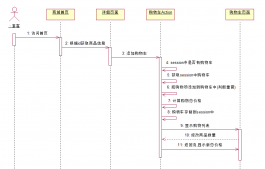一、struts2中的拦截器(框架功能核心)
1、过滤器VS拦截器
过滤器VS拦截器功能是一回事。过滤器是Servlet规范中的技术,可以对请求和响应进行过滤。
拦截器是Struts2框架中的技术,实现AOP(面向切面)的编程思想,是可插拔的, 可以对访问某个 Action 方法之前或之后实施拦截。
拦截器栈(Interceptor Stack): 将拦截器按一定的顺序联结成一条链. 在访问被拦截的方法时, Struts2拦截器链中的拦截器就会按其之前定义的顺序被依次调用
Struts2执行原理 - 底层分析
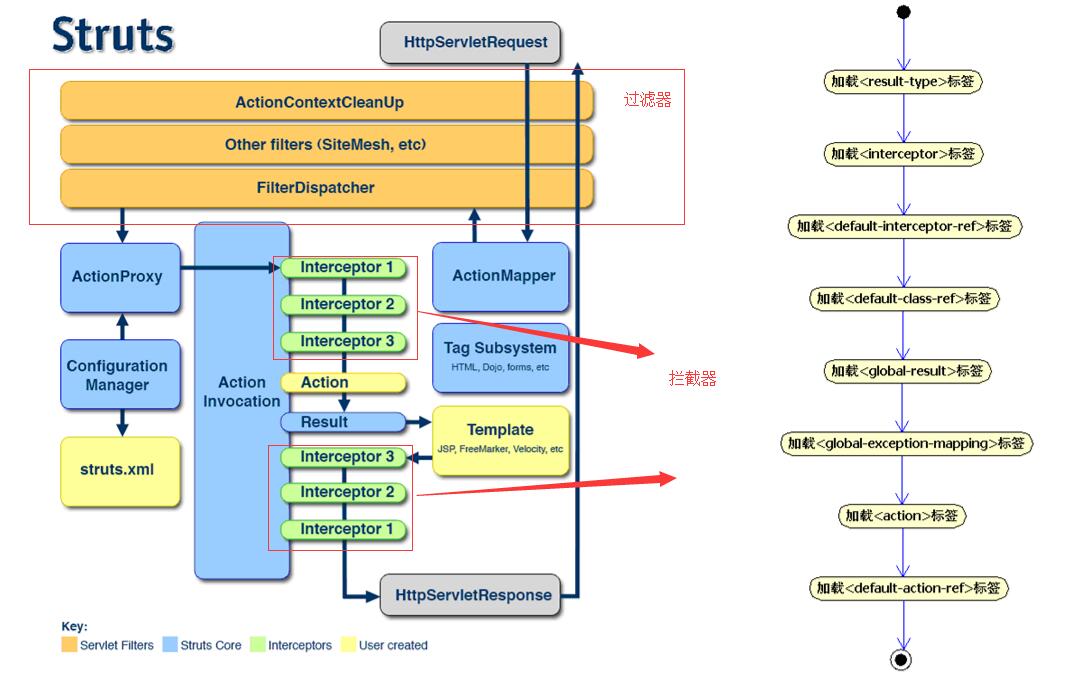
2、自定义拦截器
struts2定义了一个拦截器接口Interceptor接口。
Interceptor接口里面有三个抽象方法

•init: 该方法将在拦截器被创建后立即被调用, 它在拦截器的生命周期内只被调用一次. 可以在该方法中对相关资源进行必要的初始化
•interecept: 每拦截一个动作请求, 该方法就会被调用一次.
•destroy: 该方法将在拦截器被销毁之前被调用, 它在拦截器的生命周期内也只被调用一次.
Struts 会依次调用程序员为某个 Action 而注册的每一个拦截器的 interecept 方法.每次调用 interecept 方法时, Struts 会传递一个 ActionInvocation 接口的实例.
ActionInvocation: 代表一个给定动作的执行状态, 拦截器可以从该类的对象里获得与该动作相关联的 Action 对象和 Result 对象. 在完成拦截器自己的任务之后, 拦截器将调用 ActionInvocation 对象的 invoke 方法前进到 Action 处理流程的下一个环节.
还可以调用 ActionInvocation 对象的 addPreResultListener 方法给 ActionInvocation 对象 “挂” 上一个或多个 PreResultListener 监听器. 该监听器对象可以在动作执行完毕之后, 开始执行动作结果之前做些事情
自定义拦截器步骤:
a、编写一个类,实现com.opensymphony.xwork2.interceptor.Interceptor接口,或者继承
com.opensymphony.xwork2.interceptor.AbstractInterceptor类。(适配器模式),一般都选择继承AbstractInterceptor(拦截器会驻留内存)。因为AbstractInterceptor 类实现了 Interceptor 接口. 并为 init, destroy 提供了一个空白的实现
编写两个拦截器InterceptorDemo1 ,和InterceptorDemo2
|
1
2
3
4
5
6
7
8
9
10
11
12
13
14
15
16
17
18
19
20
21
22
23
24
25
26
27
28
29
30
31
32
33
34
35
36
37
38
39
40
41
|
package com.itheima.interceptor;import com.opensymphony.xwork2.ActionInvocation;import com.opensymphony.xwork2.interceptor.AbstractInterceptor;public class InterceptorDemo1 extends AbstractInterceptor { //动作的每次访问都会调用该方法 public String intercept(ActionInvocation invocation) throws Exception { System.out.println("拦截前Demo1"); String rtvalue = invocation.invoke();//放行,这里为什么返回string?因为最终的结果返回的Action的Result,而action的结果是string类型 System.out.println("拦截后Demo1"); return rtvalue; }}package com.itheima.interceptor;import com.opensymphony.xwork2.ActionInvocation;import com.opensymphony.xwork2.interceptor.AbstractInterceptor;import com.opensymphony.xwork2.interceptor.PreResultListener;public class InterceptorDemo2 extends AbstractInterceptor { //动作的每次访问都会调用该方法 public String intercept(ActionInvocation invocation) throws Exception {// invocation.addPreResultListener(new PreResultListener() {// // public void beforeResult(ActionInvocation invocation, String resultCode) {// System.out.println("结果显示前");// }// }); System.out.println("拦截前Demo2"); String rtvalue = invocation.invoke();//放行 System.out.println("拦截后Demo2"); return rtvalue; }} |
b、需要在struts.xml中进行定义,定义拦截器,先定义在使用。
|
1
2
3
4
5
6
7
8
|
<package name="p1" extends="struts-default"> <!-- 定义拦截器:只对当前包有效 --> <interceptors> <interceptor name="interceprotDemo1" class="com.itheima.interceptor.InterceptorDemo1"></interceptor> <interceptor name="interceprotDemo2" class="com.itheima.interceptor.InterceptorDemo2"></interceptor> </interceptors></package> |
c、在动作配置中就可以使用了
|
1
2
3
4
5
6
7
8
|
<action name="action1" class="com.itheima.action.Demo1Action" method="execute"> <!-- 使用定义的拦截器。如过没有指定任何的拦截器,默认使用default-stack栈中的所有拦截器; 一旦指定了任何一个拦截器,默认的就无效了 --> <interceptor-ref name="interceprotDemo1"></interceptor-ref> <interceptor-ref name="interceprotDemo2"></interceptor-ref> <result>/success.jsp</result></action> |
实现动作类Demo1Action
|
1
2
3
4
5
6
7
8
9
10
11
12
13
|
package com.itheima.action;import com.opensymphony.xwork2.ActionSupport;public class Demo1Action extends ActionSupport { @Override public String execute() throws Exception { System.out.println("execute执行了"); return SUCCESS; }} |
运行结果

因为struts2中如文件上传,数据验证,封装请求参数到action等功能都是由系统默认的defaultStack中的拦截器实现的,所以我们定义的拦截器需要引用系统默认的defaultStack,这样应用才可以使用struts2框架提供的众多功能。
如过没有指定任何的拦截器,默认使用default-stack栈中的所有拦截器;一旦指定了任何一个拦截器,默认的就无效了除了要使用自定义的拦截器之外,还要使用defaultStack,可以这么办
方法一:(自己使用),只需在action中配置自定义的和defaultStack默认的就可以了。

方法二:(大家都用的时候),如果希望包下的所有action都使用自定义的拦截器, 要使用拦截器栈 interceptor-stack,定义一个interceptor-stack,然后在action中可以通过<default-interceptor-ref name=“mydefaultStack”/>把拦截器定义为默认拦截器,mydefaultStack名字可以自己取。
|
1
2
3
4
5
6
7
8
9
10
11
12
13
|
<interceptors> <interceptor name="interceprotDemo1" class="com.itheima.interceptor.InterceptorDemo1"></interceptor> <interceptor name="interceprotDemo2" class="com.itheima.interceptor.InterceptorDemo2"></interceptor> <interceptor-stack name="mydefaultStack"> <interceptor-ref name="defaultStack"></interceptor-ref> <interceptor-ref name="interceprotDemo1"></interceptor-ref> <interceptor-ref name="interceprotDemo2"></interceptor-ref> </interceptor-stack></interceptors><action name="action3" class="com.itheima.action.LoginAction" method="login"> <interceptor-ref name="mydefaultStack"></interceptor-ref> <result>/success.jsp</result></action> |
3、Struts2 自带的拦截器
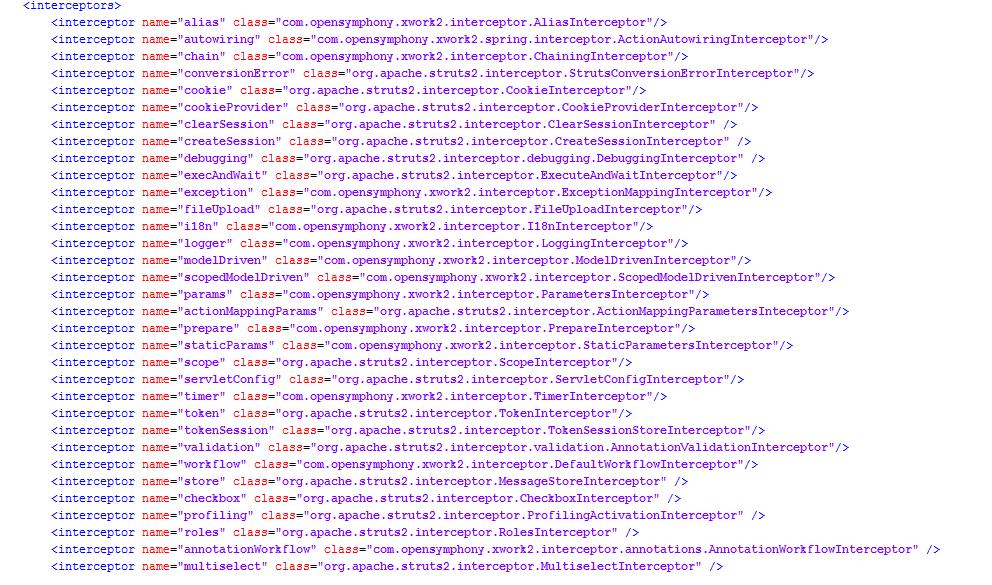
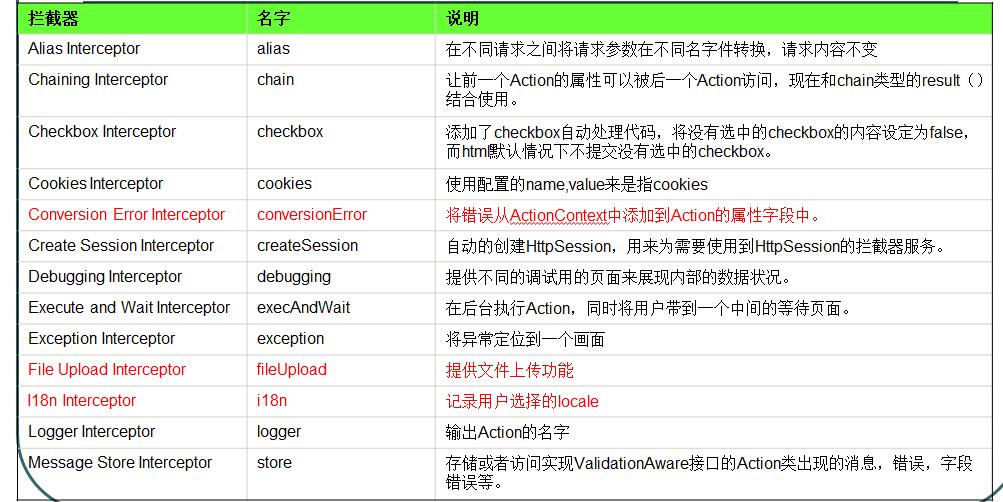
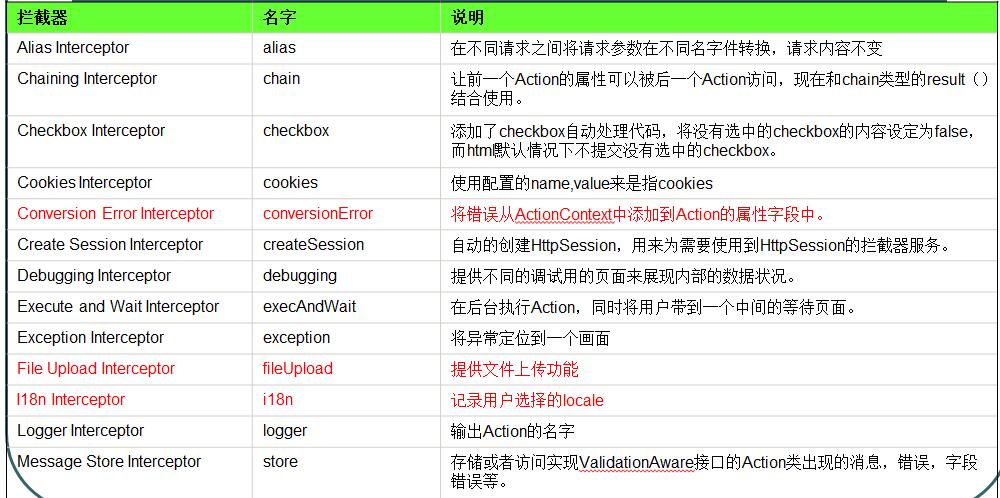
案例1:检查用户是否登录
1、 编写页面login.jsp
|
1
2
3
4
5
6
7
|
<body><form action="${pageContext.request.contextPath}/login.action" method="post"> <input type="text" name="username"/><br/> <input type="text" name="password"/><br/> <input type="submit" value="登录"/></form></body> |
2、编写登录校验的拦截器LoginCheckInterceptor 类
|
1
2
3
4
5
6
7
8
9
10
11
12
13
14
15
16
17
18
19
20
21
22
|
package com.itheima.interceptor;import javax.servlet.http.HttpSession;import org.apache.struts2.ServletActionContext;import com.opensymphony.xwork2.ActionInvocation;import com.opensymphony.xwork2.interceptor.AbstractInterceptor;public class LoginCheckInterceptor extends AbstractInterceptor { public String intercept(ActionInvocation invocation) throws Exception { HttpSession session = ServletActionContext.getRequest().getSession();//通过ServletActionContext对象获得session对象 Object user = session.getAttribute("user"); if(user==null){ //没有登录 return "login";//返回到某个逻辑视图 } return invocation.invoke();//放行 }} |
3、编写配置文件struts.xml
|
1
2
3
4
5
6
7
8
9
10
11
12
|
<package name="p2" extends="struts-default"> <interceptors> <interceptor name="loginCheckInterceptor" class="com.itheima.interceptor.LoginCheckInterceptor"></interceptor> <interceptor-stack name="mydefaultStack"> <interceptor-ref name="defaultStack"></interceptor-ref> <interceptor-ref name="loginCheckInterceptor"></interceptor-ref> </interceptor-stack> </interceptors> <action name="login" class="com.itheima.action.CustomerAction" method="login"> <result>/login.jsp</result> </action> </package> |
4、编写动作类CustomerAction
|
1
2
3
4
5
6
7
8
9
10
11
12
13
|
package com.itheima.action;import org.apache.struts2.ServletActionContext;import com.opensymphony.xwork2.ActionSupport;public class CustomerAction extends ActionSupport { public String login(){ System.out.println("登录"); ServletActionContext.getRequest().getSession().setAttribute("user", "ppp"); return SUCCESS; }} |
案例2:监测动作方法的执行效率
编写时间监测过滤器TimerInterceptor
|
1
2
3
4
5
6
7
8
9
10
11
12
13
14
15
|
package com.itheima.interceptor;import com.opensymphony.xwork2.ActionInvocation;import com.opensymphony.xwork2.interceptor.AbstractInterceptor;public class TimerInterceptor extends AbstractInterceptor { public String intercept(ActionInvocation invocation) throws Exception { long time = System.nanoTime(); String rtvalue = invocation.invoke(); System.out.println(rtvalue+"执行耗时:"+(System.nanoTime()-time)+"纳秒"); return rtvalue; }} |
编写配置文件
|
1
2
3
4
5
6
7
8
9
10
11
12
13
|
<package name="p2" extends="struts-default"> <interceptors> <interceptor name="loginCheckInterceptor" class="com.itheima.interceptor.LoginCheckInterceptor"></interceptor> <interceptor name="timerInterceptor" class="com.itheima.interceptor.TimerInterceptor"></interceptor> <interceptor-stack name="mydefaultStack"> <interceptor-ref name="defaultStack"></interceptor-ref> <interceptor-ref name="loginCheckInterceptor"></interceptor-ref> <interceptor-ref name="timerInterceptor"></interceptor-ref> </interceptor-stack> </interceptors> <result name="login">/login.jsp</result> </action> </package> |
从上面可以看出,在一个action 中可以配置多个过滤器。
4、自定义拦截器:能够指定拦截的方法或不拦截的方法
能够指定拦截的方法或不拦截的方法,编写过滤器时,可以实现类MethodFilterInterceptor,里面有两个字段,通过注入参数就可以指定那些不拦截,两个参数只要用一个即可,当拦截较少是,可以用includeMethods ,当拦截较多是,可以用排除的方法excludeMethods 。
excludeMethods = Collections.emptySet();//排除那些
includeMethods = Collections.emptySet();//包括那些
案例:再续登录校验的例子。
1、编写过滤器LoginCheckInterceptor
|
1
2
3
4
5
6
7
8
9
10
11
12
13
14
15
16
17
18
19
20
21
22
|
package com.itheima.interceptor;import javax.servlet.http.HttpSession;import org.apache.struts2.ServletActionContext;import com.opensymphony.xwork2.ActionInvocation;import com.opensymphony.xwork2.interceptor.AbstractInterceptor;import com.opensymphony.xwork2.interceptor.MethodFilterInterceptor;public class LoginCheckInterceptor extends MethodFilterInterceptor { protected String doIntercept(ActionInvocation invocation) throws Exception { HttpSession session = ServletActionContext.getRequest().getSession(); Object user = session.getAttribute("user"); if(user==null){ //没有登录 return "login";//返回到某个逻辑视图 } return invocation.invoke();//放行 }} |
2、编写配置文件
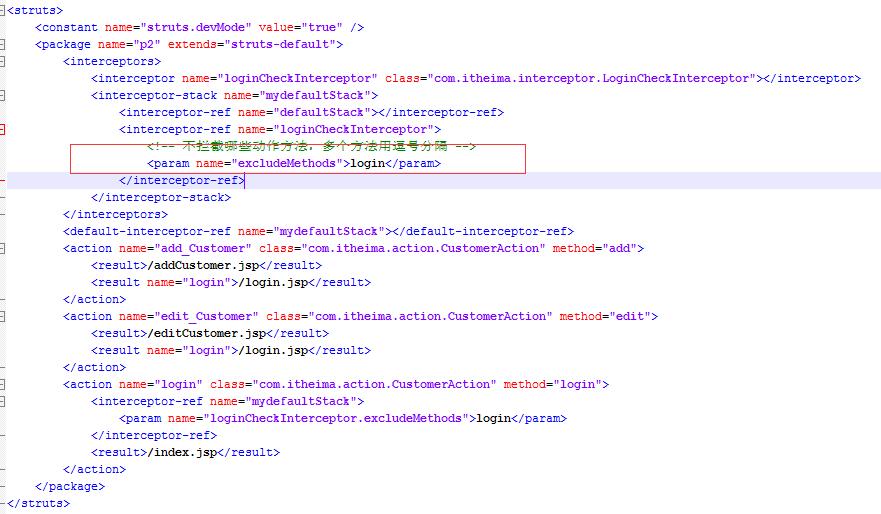
3、编写动作类CustomerAction
|
1
2
3
4
5
6
7
8
9
10
11
12
13
14
15
16
17
18
19
20
21
|
package com.itheima.action;import org.apache.struts2.ServletActionContext;import com.opensymphony.xwork2.ActionSupport;public class CustomerAction extends ActionSupport { public String add(){ System.out.println("调用add的service方法"); return SUCCESS; } public String edit(){ System.out.println("调用edit的service方法"); return SUCCESS; } public String login(){ System.out.println("登录"); ServletActionContext.getRequest().getSession().setAttribute("user", "ppp"); return SUCCESS; }} |
4、编写页面
addCustomer.jsp
|
1
2
3
|
<body>添加客户</body> |
editCustomer.jsp
|
1
2
3
|
<body>修改客户</body> |
login.jsp
|
1
2
3
4
5
6
7
|
<body><form action="${pageContext.request.contextPath}/login.action" method="post"> <input type="text" name="username"/><br/> <input type="text" name="password"/><br/> <input type="submit" value="登录"/></form></body> |
success.jsp
|
1
2
3
|
<body>oyeah</body> |
以上就是本文的全部内容,希望对大家的学习有所帮助,也希望大家多多支持服务器之家。





